story and photos by Kayte Deioma
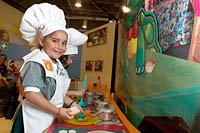 If you’re traveling with kids and they’ve had their fill of Guadalajara’s colonial history, head over to neighboring Zapopan to El Trompo Mágico, the Magic Top, for an indoor play day for the whole family. This interactive museum, which opened in 2003, has activities for kids of all ages. It’s not uncommon to see adults on their own or groups of seniors visiting Trompo Mágico as well.
If you’re traveling with kids and they’ve had their fill of Guadalajara’s colonial history, head over to neighboring Zapopan to El Trompo Mágico, the Magic Top, for an indoor play day for the whole family. This interactive museum, which opened in 2003, has activities for kids of all ages. It’s not uncommon to see adults on their own or groups of seniors visiting Trompo Mágico as well.
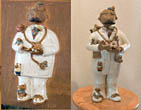 The Museum was designed as an educational enhancement to school curricula, but it won’t feel like school. The mission of Trompo Mágico is to develop a learning environment that will “uphold universal values while empowering people committed to a better world.” There are exhibits reflecting the themes of peace, diversity, equality and tolerance, but if you don’t speak Spanish you might mistake them for just more fun and eye candy.
The Museum was designed as an educational enhancement to school curricula, but it won’t feel like school. The mission of Trompo Mágico is to develop a learning environment that will “uphold universal values while empowering people committed to a better world.” There are exhibits reflecting the themes of peace, diversity, equality and tolerance, but if you don’t speak Spanish you might mistake them for just more fun and eye candy.
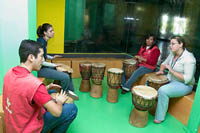 The museum is filled with helpful Nei’wáma (plural for Nei’wá, meaning friend, companion or guide in the Huichol language) to facilitate the learning experience. They can be identified by their brightly colored vests. Many of the Nei’wá are students from local colleges doing required community service hours.
The museum is filled with helpful Nei’wáma (plural for Nei’wá, meaning friend, companion or guide in the Huichol language) to facilitate the learning experience. They can be identified by their brightly colored vests. Many of the Nei’wá are students from local colleges doing required community service hours.
There is a good chance that no one at the information kiosk when you come in will speak English. If you call ahead from your hotel, they can arrange to have an English speaking guide meet you. There is also a bilingual brochure, but they may have to call upstairs to the office to find one, since they don’t always keep them at the information desk. However, you don’t need an English speaking guide or even a brochure to enjoy the activities the Trompo Mágico has to offer.
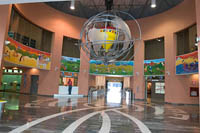 You enter the museum into a large lobby with a cutout globe around a yellow spinning top overhead. After buying your tickets, most of what you want to see and do is through the Voy Derecho (Straight Ahead) Hall of Children’s Rights, filled with touchable sculptures by local artist Rodolfo Padilla, and around the circular courtyard (or across if it’s not raining) to the Pabellón Mágico (Magic Pavilion).
You enter the museum into a large lobby with a cutout globe around a yellow spinning top overhead. After buying your tickets, most of what you want to see and do is through the Voy Derecho (Straight Ahead) Hall of Children’s Rights, filled with touchable sculptures by local artist Rodolfo Padilla, and around the circular courtyard (or across if it’s not raining) to the Pabellón Mágico (Magic Pavilion).
The Pavilion is divided into seven exhibit areas. Each exhibit area includes a reading corner with books relating to the theme of that area. The books are, of course, in Spanish.
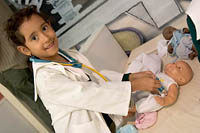 From the entrance of the Pabellón Mágico, to the far right is Maroma (Summersault), a children’s role play area. Here little ones can don the appropriate garb and get to work making tortillas and selling vegetables in a child-size market; creating and stamping letters at a mini post office; administering shots and listening for baby doll heartbeats at the hospital; cooking up and serving some yummy play food at the restaurant; or building something monumental at the construction site.
From the entrance of the Pabellón Mágico, to the far right is Maroma (Summersault), a children’s role play area. Here little ones can don the appropriate garb and get to work making tortillas and selling vegetables in a child-size market; creating and stamping letters at a mini post office; administering shots and listening for baby doll heartbeats at the hospital; cooking up and serving some yummy play food at the restaurant; or building something monumental at the construction site.
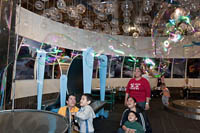 Behind Maroma to the left is Burbujas, the bubble area. I have seen a lot of cool bubble exhibits at science museums around the U.S., but this is by far the best I’ve come across. I am not quite sure how making giant soap bubbles teaches responsible consumption of water. The message gets lost in the fun of creating a giant string of bubble that stretches across the room; using teamwork to wrap a huge bubble from two long soapy poles; putting your soapy hand in and out of a sheet of bubble without breaking it, or, best of all, getting inside a massive tube of bubble.
Behind Maroma to the left is Burbujas, the bubble area. I have seen a lot of cool bubble exhibits at science museums around the U.S., but this is by far the best I’ve come across. I am not quite sure how making giant soap bubbles teaches responsible consumption of water. The message gets lost in the fun of creating a giant string of bubble that stretches across the room; using teamwork to wrap a huge bubble from two long soapy poles; putting your soapy hand in and out of a sheet of bubble without breaking it, or, best of all, getting inside a massive tube of bubble.
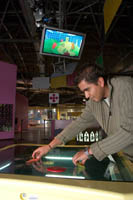 In the Garabato (Scribble) exhibit, you might expect something to do with painting, or drawing, but in reality, you’ll find a variety of high tech exhibits on modern cultural expression demonstrating how art and science come together in daily life. On the low tech end, you can join in a drum circle with traditional Brazilian drums. If you want to go more high tech, you can sit in on a jam session with electronic musical instruments. Children and adults can learn how a radio station broadcasts; create your own film and learn to edit it; experiment with four different ways of creating animated films; try your hand at digital photography; and learn how a newspaper is put together.
In the Garabato (Scribble) exhibit, you might expect something to do with painting, or drawing, but in reality, you’ll find a variety of high tech exhibits on modern cultural expression demonstrating how art and science come together in daily life. On the low tech end, you can join in a drum circle with traditional Brazilian drums. If you want to go more high tech, you can sit in on a jam session with electronic musical instruments. Children and adults can learn how a radio station broadcasts; create your own film and learn to edit it; experiment with four different ways of creating animated films; try your hand at digital photography; and learn how a newspaper is put together.
Ombligo (Belly Button) contains exhibits related to the function of the human body, but mostly in an abstract functional way, rather than anything diagrammatic. Reflexes, equilibrium, how your heart pumps and how your eyes, ears and nose work are a few of the exhibit themes. The metal bits dancing to different songs are not actually responding directly to sound waves, but rather to a computer program using sound patterns to create electromagnetic patterns. It is a representation of how your ear responds to sound, but if someone hadn’t explained it to me, I wouldn’t have gotten the underlying lesson. I did figure out that pushing the buttons for different songs made the metal bits dance differently.
Cacalota (Giant Marble) looks at the earth’s natural resources and the 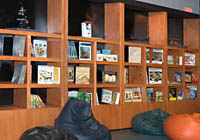 biodiversity of the planet. Learn how a tornado is formed or take a virtual reality submarine tour. The final area, Eureka, has hands-on and interactive computer exhibits allowing you to operate robots, take trip into space and explore telecommunications possibilities. This area also includes the IBM Try Science exhibit, a computer game that gives you points for learning the science behind the action.
biodiversity of the planet. Learn how a tornado is formed or take a virtual reality submarine tour. The final area, Eureka, has hands-on and interactive computer exhibits allowing you to operate robots, take trip into space and explore telecommunications possibilities. This area also includes the IBM Try Science exhibit, a computer game that gives you points for learning the science behind the action.
Back in the front building, a Tentempié (snack bar) awaits the hungry. 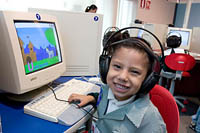 The Mediateca(Computer Room) offers dozens of computer terminals with fun and educational programs for all ages designed by the in-house educational media team. Off the main lobby is the Museum store and the temporary exhibit hall with rotating exhibits. Through February 2006, an exhibit on Charreria, Mexico’s cowboy and rodeo tradition, includes regularly scheduled
The Mediateca(Computer Room) offers dozens of computer terminals with fun and educational programs for all ages designed by the in-house educational media team. Off the main lobby is the Museum store and the temporary exhibit hall with rotating exhibits. Through February 2006, an exhibit on Charreria, Mexico’s cowboy and rodeo tradition, includes regularly scheduled 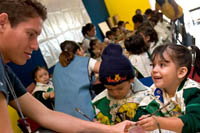 roping demonstrations. At the other end of the building, three workshops provide hands-on arts and science projects for children, teens and parents. Upstairs, a gallery between the administrative offices and the circular conference room hosts art exhibits.
roping demonstrations. At the other end of the building, three workshops provide hands-on arts and science projects for children, teens and parents. Upstairs, a gallery between the administrative offices and the circular conference room hosts art exhibits.
If it’s not raining, the grounds of the Museum offer much more to 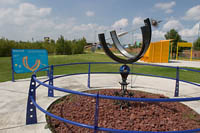 explore. Three playgrounds with age-appropriate equipment for pre-school, elementary and secondary students are near the cafeteria. On the opposite side, the Peace Labrynth is a circular maze where various activities are held promoting non-violent conflict resolution. Beyond that, on weekends and holidays you’ll find Voy que Vuelo (I can fly), which includes a sky diving simulator and canopy ride (additional fee).
explore. Three playgrounds with age-appropriate equipment for pre-school, elementary and secondary students are near the cafeteria. On the opposite side, the Peace Labrynth is a circular maze where various activities are held promoting non-violent conflict resolution. Beyond that, on weekends and holidays you’ll find Voy que Vuelo (I can fly), which includes a sky diving simulator and canopy ride (additional fee).
Trompo Mágico is located at Avenida Central 750, fraccionamiento Residencial Poniente, Zapopan, Jalisco. C.P. 45136. Hours of operation are Tuesday through Friday: 9 a.m. to 6 p.m., Weekends and holidays: 11 a.m. to 7 p.m. For general information, within Mexico call (33) 30 30 00 30 or visit the web site at www.trompomagico.com.mx

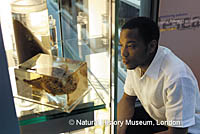 The Darwin Centre was built as an adjunct to the Natural History Museum to house and give access to the 22 million specimens collected and received by the NHM. Although it is part of the museum, the Darwin Centre’s main focus is research (when we were there last week, scientists were completing a 3 year study of the effects on marine life in the Gulf after the first Gulf War).
The Darwin Centre was built as an adjunct to the Natural History Museum to house and give access to the 22 million specimens collected and received by the NHM. Although it is part of the museum, the Darwin Centre’s main focus is research (when we were there last week, scientists were completing a 3 year study of the effects on marine life in the Gulf after the first Gulf War).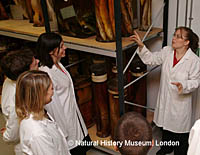 It is imperative to book a tour. It is possible to do this on-site and maybe get a tour later in the day, but this will be more difficult to do during public and school holidays. Tours last about 30 minutes and are guided by a member of the research staff. You will be asked to store in a locked locker any bags or lose articles of clothing and will be given a lab coat to wear. The guides are knowledgeable and willing to answer questions.
It is imperative to book a tour. It is possible to do this on-site and maybe get a tour later in the day, but this will be more difficult to do during public and school holidays. Tours last about 30 minutes and are guided by a member of the research staff. You will be asked to store in a locked locker any bags or lose articles of clothing and will be given a lab coat to wear. The guides are knowledgeable and willing to answer questions.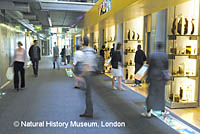 There are 27 kilometres of shelves ranged over 6 floors in the Darwin Centre as well as a large number of large metal storage containers in the basement. The specimens come from as long ago as the 1750s right up to today. All are stored in glass jars that need to be topped up regularly with alcohol to ensure their continued existence. You will not, of course, see them all; the guides pick an area and show some specimens from that section.
There are 27 kilometres of shelves ranged over 6 floors in the Darwin Centre as well as a large number of large metal storage containers in the basement. The specimens come from as long ago as the 1750s right up to today. All are stored in glass jars that need to be topped up regularly with alcohol to ensure their continued existence. You will not, of course, see them all; the guides pick an area and show some specimens from that section.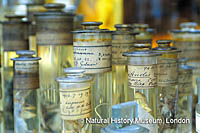 While children tend to be the ones we think of when we go to museums of this kind, I found it at least as interesting as my children did. The Darwin Centre has plans to extend the facilities by 2008 and add another building which will house their insects and larger mammals.
While children tend to be the ones we think of when we go to museums of this kind, I found it at least as interesting as my children did. The Darwin Centre has plans to extend the facilities by 2008 and add another building which will house their insects and larger mammals.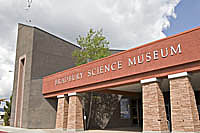 Whether you’re pro or anti, the history of the secret community of scientists who gathered in Los Alamos New Mexico during WWII to develop the first atomic bomb can’t help but fascinate. About 35 miles up the mountain from Santa Fe, the Los Alamos National Laboratory is still on the cutting edge of scientific research. The Lab isn’t generally open to the public, but the Bradbury Science Museum in the town of Los Alamos gives an overview of the Lab’s history and its current research.
Whether you’re pro or anti, the history of the secret community of scientists who gathered in Los Alamos New Mexico during WWII to develop the first atomic bomb can’t help but fascinate. About 35 miles up the mountain from Santa Fe, the Los Alamos National Laboratory is still on the cutting edge of scientific research. The Lab isn’t generally open to the public, but the Bradbury Science Museum in the town of Los Alamos gives an overview of the Lab’s history and its current research.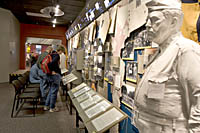 A short video gives the history of the creation of the National Science Laboratory during WWII and another on its current research. A History Gallery provides additional documents, photos, and videos on the Manhattan Project, the scientists involved and life in the secret scientific community that went nameless until after the war.
A short video gives the history of the creation of the National Science Laboratory during WWII and another on its current research. A History Gallery provides additional documents, photos, and videos on the Manhattan Project, the scientists involved and life in the secret scientific community that went nameless until after the war.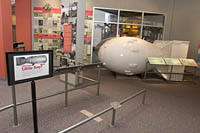 The Defense Gallery focuses on the National Security functions of the Lab and what it does to ensure the safety of existing “nuclear deterrents.” This exhibit has a “Fat Man” bomb casing identical to the one dropped on Nagasaki as well as various other missile casings. There is also an exhibit about where plutonium comes from, its risks and what measures are taken to dispose of it safely. There are a variety of interactive exhibits, including a biometric security turnstile, where you can scan an ID card (provided) and use your hand print to get through the security gate.
The Defense Gallery focuses on the National Security functions of the Lab and what it does to ensure the safety of existing “nuclear deterrents.” This exhibit has a “Fat Man” bomb casing identical to the one dropped on Nagasaki as well as various other missile casings. There is also an exhibit about where plutonium comes from, its risks and what measures are taken to dispose of it safely. There are a variety of interactive exhibits, including a biometric security turnstile, where you can scan an ID card (provided) and use your hand print to get through the security gate.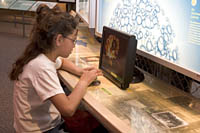 In the Research Gallery, you can learn about the human genome, space science research, radiation, lasers and other ongoing Laboratory research. The exhibits are designed for school-age children through adults. Admission is free. Many of the exhibits are interactive.
In the Research Gallery, you can learn about the human genome, space science research, radiation, lasers and other ongoing Laboratory research. The exhibits are designed for school-age children through adults. Admission is free. Many of the exhibits are interactive.